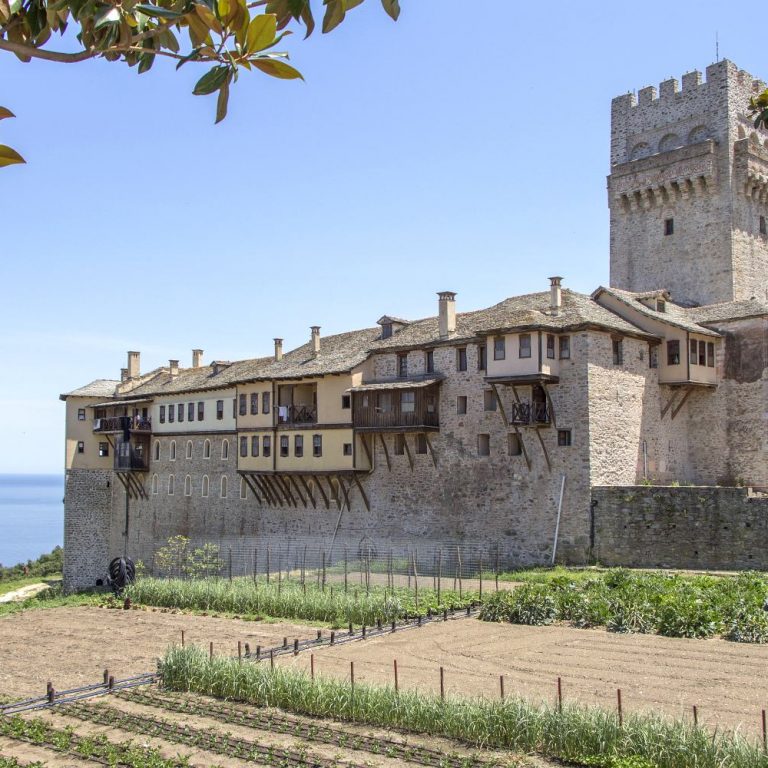The New Zenith
During the 16th century, the gradual improvement of the conditions at the Monastery are due to – apart from the general events which can be observed throughout the peninsula – and the attempts undertaken to maintain them, can be attributed to the events described below.
In 1592, the Proto Vessarios and the Holy Synod finally resolved the disputes which had been ongoing since the 13th century between the Karakallou Monastery and the Great Lavras Monastery relating to their boundaries in the area of the old Amalfinon Monastery. The same resolution was reaffirmed by Patriarch Ioannikios II in a decree in 1762.
Despite its losses after the Ottoman conquest, the Monastery continued to maintain ownership of the properties of its Byzantine dependencies. In fact, during the years of Ottoman occupation, new dependencies appear among the Monastery’s holdings, i.e. in Chalkidiki (Ierissos, Kassandra, Ormylia, Siderokausia), in Strymona (present-day New Kerdilia, and others), in the North Aegean (Thasos, Limnos and St Eustratios), in Krete, in Asia Minor, and in Vessarabia (an ancient country now part of Moldavia and the Ukraine).
The Monastery gradually continued to rise in the 16th century and in those which followed. Initiatives for the renovation and reconstruction of the building complex of the Monastery were undertaken, in particular with the generous sponsorship of the leaders of Moldavia after a legendary fire in 1530, which gift/tragedy is not recorded in any reliable source. The Vlachian leader Ioannis Petros Rares successfully recovered a number of dependencies belonging to the Monastery by purchasing them from the Ottomans in 1570, and in the end he was tonsured as a monk. The solid economic base which the Monastery had at that time was complemented by the presence of proactive monks, who funded and directed the projects themselves.
In the next century, Artchil, the King of Iberia (an ancient Northern Caucausian kingdom, in the area of present-day Georgia), and his brother Georgios Bachtag (1674), along with the monk Ioasaf and other Athonite fathers, safeguarded the welfare of the Monastery, which reached its zenith at that time with – according to some statements – several hundred (up to 500) monks residing there.
At the end of the 18th century, a period of operational irregularity due to poor management by the Sacristan Prior Gerasimos (1788) occurred, but it was short-lived and not repeated. In the years preceding the 1821 Greek Revolution for Independence, a major event which gradually changed the spiritual character of the Monastery took place: The return to a cenobitic system, which had already been reinstituted in six other Athonite monasteries. In July 1813, the Great Synod announced the decision of the Karakallou Monastery to become cenobitic in an official letter, with the hieromonk Nektarios from the Analypseos cell of the Chilandarinos Monastery appointed as Abbot. The transition to the cenobitic system was confirmed by the publication of a decree by the Patriarch Kyrillos VI the same year.
In 1592, the Proto Vessarios and the Holy Synod finally resolved the disputes which had been ongoing since the 13th century between the Karakallou Monastery and the Great Lavras Monastery relating to their boundaries in the area of the old Amalfinon Monastery. The same resolution was reaffirmed by Patriarch Ioannikios II in a decree in 1762.
Despite its losses after the Ottoman conquest, the Monastery continued to maintain ownership of the properties of its Byzantine dependencies. In fact, during the years of Ottoman occupation, new dependencies appear among the Monastery’s holdings, i.e. in Chalkidiki (Ierissos, Kassandra, Ormylia, Siderokausia), in Strymona (present-day New Kerdilia, and others), in the North Aegean (Thasos, Limnos and St Eustratios), in Krete, in Asia Minor, and in Vessarabia (an ancient country now part of Moldavia and the Ukraine).
The Monastery gradually continued to rise in the 16th century and in those which followed. Initiatives for the renovation and reconstruction of the building complex of the Monastery were undertaken, in particular with the generous sponsorship of the leaders of Moldavia after a legendary fire in 1530, which gift/tragedy is not recorded in any reliable source. The Vlachian leader Ioannis Petros Rares successfully recovered a number of dependencies belonging to the Monastery by purchasing them from the Ottomans in 1570, and in the end he was tonsured as a monk. The solid economic base which the Monastery had at that time was complemented by the presence of proactive monks, who funded and directed the projects themselves.
In the next century, Artchil, the King of Iberia (an ancient Northern Caucausian kingdom, in the area of present-day Georgia), and his brother Georgios Bachtag (1674), along with the monk Ioasaf and other Athonite fathers, safeguarded the welfare of the Monastery, which reached its zenith at that time with – according to some statements – several hundred (up to 500) monks residing there.
At the end of the 18th century, a period of operational irregularity due to poor management by the Sacristan Prior Gerasimos (1788) occurred, but it was short-lived and not repeated. In the years preceding the 1821 Greek Revolution for Independence, a major event which gradually changed the spiritual character of the Monastery took place: The return to a cenobitic system, which had already been reinstituted in six other Athonite monasteries. In July 1813, the Great Synod announced the decision of the Karakallou Monastery to become cenobitic in an official letter, with the hieromonk Nektarios from the Analypseos cell of the Chilandarinos Monastery appointed as Abbot. The transition to the cenobitic system was confirmed by the publication of a decree by the Patriarch Kyrillos VI the same year.

